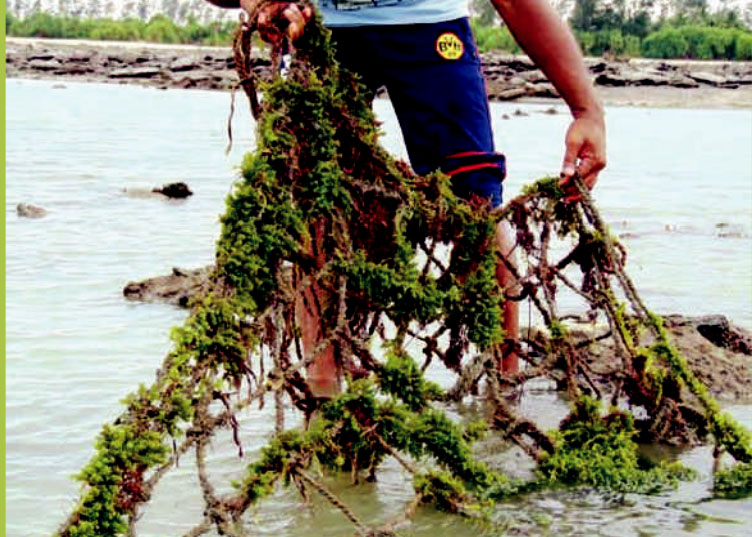Cultivation, Processing and Marketing of Seaweed (Shaibal)
IDF, with the assistance of PKSF, had initiated a project entitled ‘Creation of Employment for Poor People of Coastal Areas through Cultivation, Processing and Marketing of Seaweed (Shaibal) in the year 2018-19. Shaibal is seaweed that possesses nutritional and medicinal values. It is not commonly cultivated in our country, but there are about 10 varieties of Shaibal found in our mangrove. The University of Chittagong has recently recommended its produc-tion technology for cultivation in our country.
Selection of area:
Shaibal, being a sea weed, is usually grown in coastal areas, and in Bangladesh, it is found to be naturally grown along the coastal belt of Cox’s Bazar, particularly in the villages of Nuniar-char and other adjacent areas.

The women farmers of the areas were familiar with shaibal. They were usually the collectors of shaibal and use them in traditional ways. They had no ideas of cultivating them in a modern way. Marketing of sea weed was unknown to them.
Selection of cultivators:
After the initiation of the project, the women collectors of sea weed were contacted. These women showed interest in cultivating shaibal and adopting the modern technologies, if they were provided with training. The project officials had identified and listed about 200 women farmers interested in growing shaibal.
Designing a training course:
The project designed a 1-day training course. The course content comprised of improved methods of cultivation of shaibal, its processing and marketing. The training was organized and conducted by the project. In addition to project officials, subject matter specialists from Bangladesh Agricultural Research Institute (BARI), Forest Research Institute (FRI), Upazila Fisheries Officer of Cox’s Bazar were invited as guest speakers. A practical session was also included to demonstrate the cultivation method.
Conduct of training programs:
Altogether 7 courses were conducted during the year 2020. Four courses were offered in January and March 2020 and 3 courses in November and December 2020. In each course, 25 women cultivators attended these courses as participants. Therefore 100 women cultivators, 25 in one batch, took part in the training programs held in January/March. Other 75 women cultivators participated in 3 courses during November-December 2020. Altogether 175 women cultivators were trained during the year 2020.
Cultivation of Shaibal:
Out of 100 women farmers trained in early part of the year, 55 participants were selected for cultivation. They were directly assisted in their cultivation to develop their areas as demonstration plots. From the 75 participants trained in November-December, 25 women farmers were selected and provided guidance to develop their areas as demonstration plots too. For developing demonstration plots, these farmers were provided with some supports and assistances from the project. These were described below.
Supports provided to the farmers:
All the selected farmers were provided with materials and inputs for their cultivation. The materials included were 14 kgs of rope, 4 bamboos, 20 floats, 1 drum, 1 tab (balti), 1 knife, net, packets of polythene and one pair of gumboot for each farmer. Necessary technical guidance was provided to them and their cultivation processes were closely supervised.
Production of Shaibal for 55 farmers:
Production of shaibal and its related information regarding the area of plantation, production (wet and dry), duration, total expenses, market value and net profit of the demonstration plots from the 55 women farmers during the year 2019-20 were shown in Table 35. It was observed that by cultivating shaibal, these 55 women farmers earned a net profit of BDT 11,09,610 meaning an average net profit of BDT 20,175 by 4 months.
Cultivation season of Shaibal:
The cultivation season of Shaibal starts from the month of September-October and continues till March-April. This is the season when saline water is available and the plants grow well. Usually, shaibal is harvested every fortnight i.e
twice a month during this period. Two varieties, Hipnia and Ulva are grown in Nuniarchar area. Of course Hipnia is a more popular variety than Ulva. Hipnia is more expensive and has higher market demands. However, when the rain comes in April-May, salinity of water reduces because of inflow of sweet water and the plants do not grow well. Shaibal is harvested wet, and can be sun-dried well because of sunny weather prevailing during the harvesting time. Some farmers of course sell wet shaibal also

